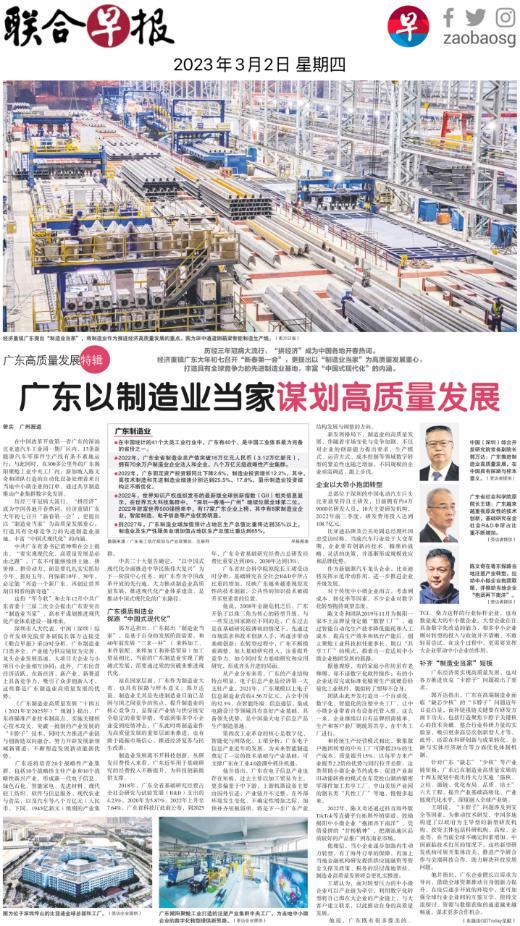"Guangdong's OEM (Original Equipment Manufacturer) service took off 45 years ago, driving the province's foreign trade and overall development for years. Now that Guangdong's manufacturing industry has achieved leapfrog development, it needs a qualitative breakthrough to drive further growth," said Guo Wanda, Executive Vice President of China Development Institute (CDI).
The government of Guangdong vowed to improve the quality of its development on January 28, the first working day after the Chinese New Year, and emphasized that the manufacturing industry will play a fundamental role along its path to modernization.
To improve the quality of development, Guangdong highlights 20 strategic industrial clusters and eight industrial clusters with more than 1 trillion RMB in output, including new-generation electronic information, green petrochemicals, intelligent home appliances, advanced materials, modern light industry and textiles, software and information services, modern agriculture and food, and automobiles.

Shenzhen-Zhongshan Bridge's steel box girder intelligent production line[Photo/Nanfang Daily]
"The manufacturing industry, especially advanced manufacturing, is now the focus of competition between countries. As China's economic powerhouse, Guangdong emphasizes manufacturing industry for high-quality development and it is expected to boost market confidence and promote economic recovery," Guo told GDToday and Lianhe Zaobao in a joint interview on the high-quality development in Guangdong.
Manufacturing industry upgraded through increased R&D input
In 2018, Guangdong's basic research funding accounted for 4.23 percent of the total research and experimental development (R&D) expenditure. Guangdong has been increasing investment in basic research as the number grew to 5.87 percent in 2020 and 7.64 percent in 2022.
According to the Department of Science and Technology of Guangdong Province, the province's basic research spending will account for 10 percent of total R&D spending by 2025 and 13 percent by 2030.
Wang Jun, Former President of the Guangdong Academy of Social Sciences, analyzed the increase in basic research investment, indicating that the province attaches great importance to original technological innovation.
Wang explained that Guangdong has been upgrading its industries since 2008. Compared with some developed countries, the province started with market demands and technological innovation, as its basic research was relatively weak. As the investment in basic research has increased, now Guangdong drives its development with both basic research and application research.
In addition, Wang believes that the electronic information industry, a pillar industry of Guangdong, will provide the technologies and industrial facilities needed for smart manufacturing and enable the province to seize opportunities in Industry 4.0.
In 2021, Guangdong's electronic information manufacturing industry above the designated size had revenue of 4.56 trillion RMB, accounting for 32.3 percent of China's total. Guangdong has an excellent industrial base in the fields of intelligent terminals, information and communication, and integrated circuit design, according to the Department of Industry and Information Technology of Guangdong Province.
"Guangdong manufacturers and their global counterparts will have more chances for communication and cooperation as China eased the travel restriction in January. Guangdong manufacturers are sensitive to market demand, and good at improving their technological innovation capability with global resources," said Wang.
SMEs suggested to pursue quality development with large enterprises
Large enterprises pursue high-quality development by enhancing their R&D capacity. BYD, one of the leading electric vehicle manufacturers, has about 49 thousand R&D staff members, and spent 10.87 billion RMB on R&D in the first three quarters of 2022. The company also has intelligent and automated production lines.

BYD's global headquarter and factory in Guangdong's Shenzhen [Photo/BYD]
"Large-scale companies such as Midea, TCL, and Greek can take the lead in digitalization and automation as they can afford the costs in the trial period. But the cost and conversion rate of industrial upgrade frighten small and mid-size enterprises (SMEs) away," said Wang.
He suggested that SMEs could work with big companies, which are often their clients, to achieve high-quality development.
In addition, the "shared factories" model was launched in Guangdong in recent years, providing SMEs with manufacturing space and a digitalized control system to improve efficiency.
"We found that there is a large number of SMEs in the traditional manufacturing industry in the Teochew region of Guangdong (which consists of Chaozhou, Shantou, Jieyang, and Shanwei). Most of these manufacturers are unfamiliar with digital technologies and incapable of using the software. Even though some manufacturers have applied industrial software in production, they don't have standard equipment to match the software," said Tan Boon Kee, Chairman of Jieyang Symbiosis Industry Co, Ltd.
Tan and his team started a "smart factory" model for a manufacturer in Jieyang in 2019, which can reduce labour costs and increase efficiency through automation production technology. In 2020, Tan established Jieyang Symbiosis Industry Co, Ltd and set up a shared-smart-factory for SMEs.
According to Tan, compared to the traditional production model, the shared-smart-factory help SMEs reduce production costs by 25 percent and increase production quality by 15 percent.

GDToday conducts a joint interview with Lianhe Zaobao, the biggest Chinese media outlet in Singapore, on the trend of high-quality development in Guangdong.
Reported by Jasmine, Nina
Edited by Wing, Steven, James
版权及免责声明:凡本网所属版权作品,转载时须获得授权并注明来源“欧洲侨报”,违者本网将保留追究其相关法律责任的权力。凡转载文章,不代表本网观点和立场。版权事宜请联系:0040-751021899。
版权所有:欧洲侨报苏ICP备17070786号-1